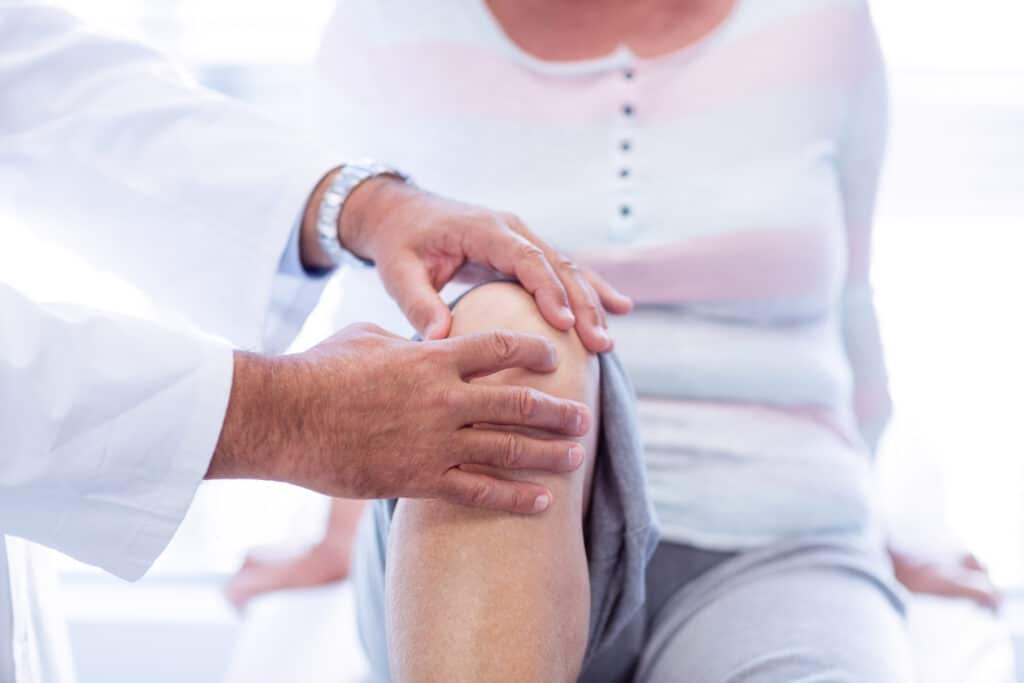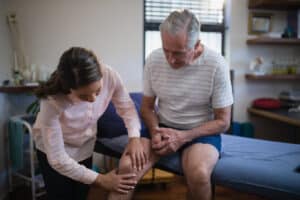If you’ve ever wondered about the crackling sounds your knees make when you bend or extend them, you might be experiencing a common occurrence known as knee crepitus.
This article will unravel the mystery behind these curious noises and share some practical exercises for pain relief and joint mobility.
Understanding Knee Crepitus
Your knee joint is a marvel of nature, a complex network of bones, cartilage, and tendons working in unison to get you from place to place. Each component facilitates smooth movement and supports your body’s weight.
But, like a regularly used machine, your knee joint can experience wear and tear over time. The cartilage cushions the bones but can deteriorate due to daily activities and the natural aging process.
This degeneration can lead to uneven surfaces on the bones. When these roughened areas rub against each other, they can produce the characteristic crackling or popping sound we know as knee crepitus.
To visualize this, imagine the friction between two pieces of sandpaper. As they rub against each other, they produce a distinct sound. Similarly, the friction between the bones and cartilage in your knee joint can result in audible knee crepitus.
Common Causes of Knee Crepitus
Now, you might be thinking, “Should I be worried?” The answer is usually no.
Our bodies naturally change as we age, and our joints are no exception. Knee crepitus is often a harmless phenomenon. It tends to be more prevalent as we age due to the cumulative effects of years of movement.
As a physical therapist, I reassure my patients that if their joints are making noise but aren’t painful, it’s typically nothing to fret over. It’s simply your knees stating that they’ve had some experience.
However, if you do experience pain or discomfort alongside the noise, it’s important to seek professional guidance. Pain could indicate a more serious underlying condition, such as osteoarthritis or a meniscus tear, which may require medical intervention or physical therapy.
The following are some of the most common causes of knee crepitus.
Osteoarthritis & Thinning of Cartilage
Osteoarthritis (OA) is a common chronic inflammatory condition that leads to the breakdown of cartilage in the joints.1
Cartilage is the smooth and rubbery tissue covering the ends of bones where they form a joint. It facilitates smooth movement, ensuring your joints work smoothly and pain-free.
As OA develops, the cushion gradually thins like the sole on a well-worn shoe. Knee crepitus, or the sound of cracking and popping, is one of the more common signs of knee OA.
What if There is Pain with Crepitus?
If you have osteoarthritis and crepitus, you may benefit from wearing a compression brace with lateral support. This type of brace can reduce inflammation, improve blood flow, and provide some stability for your knee. Just remember this is a “comfort fix”, not a long-term solution. You’ll still want to follow up with your physical therapist for exercises and other therapies that can help you manage your pain and prevent further damage to your knee from osteoarthritis.
The highly rated Neenca Compression Knee Sleeve is the brace we most often recommend to our patients.
Our recommendations are the same items we trust and prescribe to patients. When you buy through links like this on our site, we may earn an affiliate commission to support new content.
Changes in Synovial Fluid
Synovial fluid is the lubricating substance that helps reduce friction within our joints. With age, the production and quality of synovial fluid can change, leading to less effective lubrication.
The resulting lack of adequate lubrication can contribute to the creaking or cracking sensations when we move.
Muscle Weakness
Muscles are like the scaffolding around the joint, providing support and stability.
Muscle mass naturally decreases as we age, leading to weaker supporting structures around the joints. This weakness can result in less efficient movement and potentially contribute to the creakiness of crepitus.
Inflammation
Inflammation is an unfortunate but common companion of aging. It can also result from sudden increased activity that your body may not have been fully prepared for.
For example, Patellofemoral Pain Syndrome (PFPS) and Osteoarthritis (OA) are inflammation-related conditions that can increase bone friction and result in pain when you move.2
Changes in Bone Structure
Bone density and structure changes are also a natural part of aging. These changes can affect how our bones interact within the joints, potentially leading to increased sounds during movement.
When bone structure change — or muscle weakness causes imbalance, it’s similar to a car’s tires being out of alignment, leading to squeaking and creaking. Much like that car, if these new imbalances go unaddressed, they can lead to problems beyond simple joint sounds.
When Knee Crepitus is a Problem
Knee crepitus can be troubling for some older people. But often, it’s just a normal part of the aging process. Studies have shown that those with crepitus perform just as well on strength and functional testing as those without it.1
Regardless, it’s crucial to listen to your body. If your knee cracking is accompanied by pain, swelling, or restricted movement, it’s time to seek advice from a healthcare professional. Timely attention to any painful joints can make a world of difference in the rehab and recovery process.
In the next section, we’ll explore some exercises to help maintain joint mobility and alleviate discomfort associated with knee crepitus.
Practical Exercises for Knee Pain Relief
As with many conditions, exercise can benefit those living with knee crepitus. Remember, these exercises are not a substitute for professional medical advice but can be a valuable addition to your overall knee health strategy.
It’s essential to start slowly and listen to your body. If you experience discomfort or pain, consult a healthcare professional before continuing.
Gentle Movements and Stretches
Quadriceps Stretch
- Stand with the chair seat near the leg you plan to stretch.
- Place the knee of the stretch leg on the chair seat, step the other foot forward, and lean gently toward the standing leg.
- Squeeze your butt muscles as you lean forward to avoid arching your back.
- Hold the stretch for about 15-30 seconds.
- Release and switch to the other leg.
Hamstring Stretch
- Place your foot on a low, stable surface like a step or a chair.
- Keeping your knee straight, gently lean forward from your hips.
- You should feel a stretch along the back of your thigh.
- Hold for 15-30 seconds, and then switch legs.
Calf Raises
- Stand behind a sturdy chair or a countertop for balance.
- Rise up onto your toes, lifting your heels off the ground.
- Hold the position for a few seconds, then lower your heels back down.
- Repeat for 10-15 repetitions.
Seated Knee Extensions
- Sit on a chair with your back straight and feet flat on the floor.
- Slowly extend one leg out in front of you, keeping your knee straight by squeezing your quads (your thigh muscles).
- Hold for a few seconds, then lower your leg back down.
- Repeat for 10-15 repetitions on each leg.
Foam rolling
Using a foam roller on your thigh or calf muscles can be really helpful if there are areas where you feel like you might have a “knot” or trigger point.
If you find a tender area while performing this release technique, try holding pressure on it for a few seconds, if tolerable, to help dissipate some of the muscle tension.
Though uncomfortable, my patients often feel relieved after these techniques. It’s like giving your muscles a deep-tissue massage!
Remember, these exercises are not just about relieving pain but also about promoting overall joint health. So, let’s get moving and keep those knees happy!
Strength Exercises for the Muscles Surrounding the Knees
Think of the muscles around your knee joint as your knee’s best friends. They’re always there, providing support and as a protective shield. They help reduce the strain on the joint, offering balanced support and strength.
Research shows negligible differences in knee strength between those with and without crepitus. However, keeping your joints healthy and strong is beneficial for several reasons.1,4
Let’s explore a few exercises that can help you enhance the strength of these critical muscles.
Step-Ups
- Find a stair, curb, or other stable platform you feel comfortable safely stepping onto, ideally with a wall or other stable handhold for support.
- Step one foot onto the platform, then lift your other leg to join it so you’re standing with both feet on the platform.
- Step back down with the first foot, followed by the second.
- Alternate legs and repeat for 10-15 step-ups on each leg.
As always, having a stair rail or some other stable support for this or other exercises that may be challenging for your balance is best.
Lunges
- Stand with your feet hip-width apart. Use a chair or stable surface to assist with balance.
- Step one foot forward a few feet before you, maintaining a comfortable stance.
- Bend both knees, lowering your body while keeping your front knee above your ankle and back knee hovering.
- Push through the front heel to stand.
- Alternate sides and repeat. Remember to maintain good posture and control throughout the movement.
Standing Hamstring curls
- Begin standing tall with your hands on a chair or table for support.
- Bend one knee, bringing your heel towards your glutes, like you’re trying to kick yourself in the rear.
- Slowly lower your leg back down.
- Repeat on the other leg.
- Engage your hamstring muscles as you lift your leg and focus on controlled movements. You can perform this exercise with light to medium ankle weights for an extra challenge.
These exercises are designed to be gentle on your knees. Start at a comfortable intensity and gradually increase as your strength improves. Regularly performing these exercises ensures that the muscles supporting your knees remain strong to stay active despite a slight crepitus.
Key Takeaways
- Knee crepitus, characterized by a crackling or popping sound in the knee, is common, often due to the natural aging process and wear and tear on the knee joint.
- The sound is produced when the roughened surfaces of the bones, caused by the deterioration of cartilage, rub against each other.
- Knee crepitus is generally harmless and more prevalent as we age. Still, if it is accompanied by pain or discomfort, it could indicate a more serious condition, like osteoarthritis or a meniscus tear.
- Osteoarthritis is a chronic inflammatory condition that causes cartilage to breakdown in the joints, often resulting in knee crepitus.
- Changes in synovial fluid, muscle weakness, inflammation, and changes in bone structure are other common causes of knee crepitus.
- If knee crepitus is accompanied by pain, swelling, or restricted movement, it’s important to seek advice from a healthcare professional.
- Gentle movements and stretches can help maintain joint mobility and alleviate discomfort associated with knee crepitus.
- Strengthening the muscles surrounding the knee joint can help reduce strain on the joint, offering balanced support and strength.
FAQs
What is knee crepitus, and should I be concerned?
Knee crepitus is the crackling or popping sounds that sometimes occur when bending or extending the knees. It’s usually a harmless result of wear and tear on the joint surfaces as we age. However, if these sounds are accompanied by pain, swelling, or restricted movement, it could indicate a more serious condition like osteoarthritis or a meniscus tear, and you should seek medical advice.
What causes knee crepitus?
Knee crepitus is often caused by the deterioration of cartilage, leading to roughened joint surfaces that produce noise during movement. Other common causes include changes in synovial fluid, muscle weakness, inflammation, and changes in bone structure. These factors can make the joint surfaces less smooth, resulting in the characteristic sounds.
How does osteoarthritis relate to knee crepitus?
Osteoarthritis (OA) is a chronic condition leading to the breakdown of joint cartilage. As the cartilage wears away, the bones can begin to rub against each other, causing the crepitus sound. OA can also cause pain and swelling, making it important to consult a healthcare professional if these symptoms occur alongside crepitus.
Can muscle weakness contribute to knee crepitus?
Yes, muscle weakness can contribute to knee crepitus, especially in the muscles surrounding the knee joint. Weak muscles may not support the joint as effectively, leading to misalignment and increased friction within the joint. Strengthening these muscles can help reduce crepitus and improve joint stability.
Is knee crepitus related to changes in synovial fluid?
Yes, changes in the quality or quantity of synovial fluid, which lubricates the joints, can contribute to knee crepitus. As we age, the production and effectiveness of synovial fluid can diminish, leading to increased friction and the creaking or popping sounds associated with crepitus.
When should I see a doctor about knee crepitus?
You should see a doctor if knee crepitus is accompanied by pain, swelling, restricted movement, or if it significantly impacts your daily activities. These symptoms may indicate a more serious underlying condition, such as osteoarthritis or a meniscus injury, requiring professional evaluation and treatment.
What exercises can help with knee crepitus?
Exercises that strengthen the muscles around the knee can help reduce crepitus. Gentle stretches and movements, such as quadriceps stretches, hamstring stretches, calf raises, and seated knee extensions, can improve joint mobility and alleviate discomfort. Always start slowly and consult a healthcare professional if you experience pain during exercise.
Are there any long-term effects of knee crepitus?
Knee crepitus itself is usually not harmful, but if it is associated with pain or other symptoms, it could indicate underlying joint issues like osteoarthritis. Addressing the underlying causes through physical therapy and strengthening exercises can help prevent potential long-term complications, such as joint degeneration or decreased mobility.
References
- Pazzinatto, M. F., de Oliveira Silva, D., Faria, N. C., Simic, M., Ferreira, P. H., de Azevedo, F. M., & Pappas, E. (2019). What are the clinical implications of knee crepitus to individuals with knee osteoarthritis? An observational study with data from the osteoarthritis initiative. Brazilian journal of physical therapy, 23(6), 491-496.
- de Oliveira Silva, D., Pazzinatto, M. F., Del Priore, L. B., Ferreira, A. S., Briani, R. V., Ferrari, D., … & de Azevedo, F. M. (2018). Knee crepitus is prevalent in women with patellofemoral pain, but is not related with function, physical activity and pain. Physical Therapy in Sport, 33, 7-11.
- Lun, V., Marsh, A., Bray, R., Lindsay, D., & Wiley, P. (2015). Efficacy of hip strengthening exercises compared with leg strengthening exercises on knee pain, function, and quality of life in patients with knee osteoarthritis. Clinical Journal of Sport Medicine, 25(6), 509-517.
- Drum, E. E., Kovats, A., Jones, M. D., Dennis, S., Naylor, J., Mills, K., & Thom, J. M. (2023). Creaky knees: Is there a reason for concern? A qualitative study of the perspectives of people with knee crepitus. Musculoskeletal Care.








